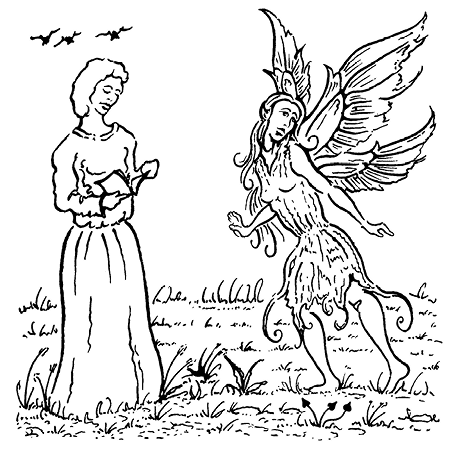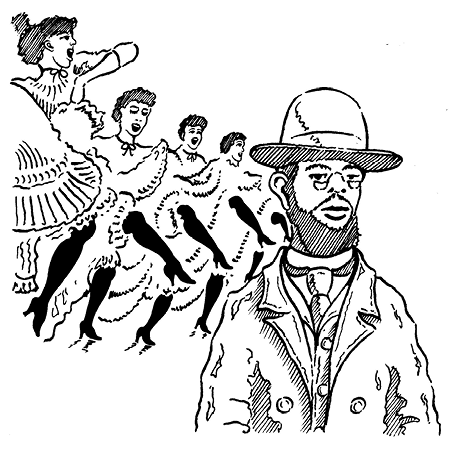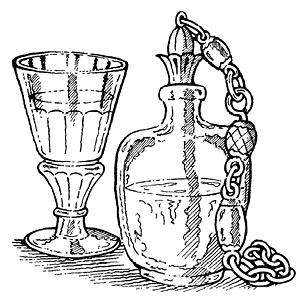Absinthe: The Mystique
of the Green Fairy
by Denise Dumars
No alcoholic beverage has been so whispered about, seemed so scandalous, and deemed so magical as absinthe. Now that absinthe is legal again in the United States and the European Union after having been illegal for over a century in some countries (but not the Czech Republic, Spain, Cuba, or Mexico) people are talking about it, imbibing, and expecting, well, interesting results.
A distillation process created spirits—called so because they came out of the alembics of the alchemists—but absinthe, invented in 1787, was a latecomer to the distillery. Before then, people drank Artemisia absinthium, also known as wormwood, by steeping the herb in wine. An anthelmintic, the name “wormwood” indicates that the herb was used in ancient times to expel worms from the digestive systems of people and animals. But that’s not very magical—no, the real excitement came when writers, artists, musicians, actors, and other creative types declared absinthe to be their Green Muse and called that muse the Green Fairy.
Stoking the Muse
A Muse, in classical mythology, is one of nine goddesses who inspires a form of literature, science, or the arts. We attribute the Muses to the Greeks, and later the Romans, but they are far older. Debate continues over whether they originated in ancient cultures of Europe, such as Thracian, or in those of ancient African nations, such as Egypt and Ethiopia. It is certain, however, that by the time the Greeks adopted the idea, each Muse was given certain attributes. For example, Calliope was the Muse of epic poetry, and Terpsichore was the Muse of dance. This meant that poets, dancers, artists, and scientists each had their own deity to pray to for inspiration.

The idea of a muse never left, even when monotheism overtook the polytheistic faiths. After that, muses were often seen as individuals, places, or things that inspired the creative process. One’s spouse, one’s homeland, or even one’s pet or a particular flower could act as a muse. The Green Muse, however, took creativity back to the days of gods and goddesses and magic. In much of Europe, folklore about fairies and similar spirits persisted, and so the spirit of absinthe was called the Green Fairy to honor its magical powers of inspiring creativity.
A Special Quaff
Just how does one differentiate an ordinary distilled liqueur—and there are many of them—from one that invokes a magical muse? For that, we have to learn the properties of the herbal formula that creates absinthe and also consider its history.
Grand wormwood—one of the Artemisias—is just the beginning. People obsess over the idea of the chemical thujone, found not only in wormwood but in closely related plants such as southernwood, mugwort, and all the salvias, as well as the six varieties of arborvitae trees of the genus Thuja. Many of the Artemisias are recommended as drought-resistant garden plants. So, what’s the big deal about absinthe?
First of all, we must go back to the nineteenth century—the golden age of absinthe. For a time in France during a wine shortage, absinthe, which is normally a very expensive liqueur, became cheaper than wine. Most writers, artists, and creative types had very little money, so they began drinking absinthe. And it was most likely then that they discovered its special properties.
Interesting, but where does the magic come in? Well, for one thing, many writers, artists, and musicians of the Victorian Era belonged to the ever-more-popular occult lodges that were springing up in Europe and the United States at the time. For some it was a return to their Celtic heritage, while for others the newfound intellectual freedom had inspired curiosity about pre-Christian religious practices. Aleister Crowley was, of course, a fan of absinthe, but he came along afterward, when the Lost Generation (including Ernest Hemingway, James Joyce, Gertrude Stein, Isadora Duncan, and even Crowley himself) named themselves to express a sense of disoriented wandering during the time of World War I. Sounds like an idea that came out of absinthe imbibing to me!
It helps that absinthe is also associated with magical places that conjure up images of Gothic subculture and vampires, Voodoo and Santería, and libertine lifestyles: Paris, of course, but also Prague, New Orleans, Havana, Amsterdam, Barcelona, the Florida Keys, Martinique, and more.
But back to the Victorians. Charles Baudelaire, an ardent absintheur, was a major force in the Decadent movement of literature and loved to shock people with his interest in Satanism. Arthur Machen, Algernon Blackwood, W. B. Yeats, Arthur Conan Doyle, Bram Stoker, Maud Gonne, and A. E. Waite are just a few of the literary lights that belonged to the Golden Dawn, espoused Spiritualism, or practiced other occult arts, often under the inspiration of absinthe.

Only Oscar Wilde—probably the biggest absinthe booster of his day—denied a belief in any spiritual or magical power. But he believed in the power of absinthe, as did Henri de Toulouse-Lautrec, Vincent van Gogh, Henri Matisse, Paul Gauguin, Guy de Maupassant, and Émile Zola, who comprised a large contingent of absintheurs who frequented the infamous Moulin Rouge during what was called the Belle Époque—also known as the Gilded Age—during the years 1871 to 1914. It is from these writers and artists that we know the most about the effects of absinthe.
When those well-known creative people and bohemian society in general began to get a bad rap, so did absinthe. Whether this truly happened or not, it was no surprise that the drink was seen as nefarious after a man in Switzerland supposedly killed his wife and family while under its influence. One after another, countries in Europe and the Western Hemisphere began to ban absinthe. There were only a few exceptions, such as Cuba, which is where Hemingway became acquainted with it.
Absinthe and Occultism
Back to our occultists. For them, the Green Fairy was a way to initiate themselves into the Mysteries. Divination, communing with the gods, creating ecstatic states of being, and many other mystical states and actions could be accessed through the use of absinthe. But what of the Green Muse? Well, this comes from absinthe’s interesting effects, which are far different from most alcoholic beverages. Writers, musicians, and the like found that although absinthe certainly made them drunk, it appeared to leave the mind wide awake! Most people know that alcohol normally inhibits creativity, but with absinthe, the opposite seemed to be happening. Medically speaking, this is because wormwood is a stimulant, which obviously counteracted some of the soporific effects of the alcohol in absinthe. Medical literature lists many active ingredients in wormwood besides thujone, including antioxidants, and there are some proven medical uses.
Scientists list numerous chemicals that act on the brain and body. The well-documented article on wormwood on Drugs.com states that some of the major components of wormwood oil include chamazulene and nuciferol butanoate, among others. The article explains that its essential oils contain aromatic compounds and oxygenated monoterpenes, which contribute to a “pleasant-smelling volatile oil,” as well as phellandrene, pinene, azulene, and more.
Wormwood is extremely bitter, so when it is made into a liqueur it is heavily flavored with sugar or honey, and a whole apothecary of sweeter herbs (such as anise, fennel, chamomile, hyssop, angelica, calamus, lemon balm, star anise, and spearmint), many of which contain medicinal properties themselves. Of course, wormwood relatives mugwort and southernwood are also sometimes added. It’s a list that’s starting to look a lot like a Witches’ herbal if you ask me!
Nevertheless, the chemical that worries doctors is thujone, for in high doses it is a convulsant and does cause seizures. Wormwood essential oil should be strictly avoided, and absinthe should only be drunk in moderation under controlled circumstances, like in a ritual. Problems with absinthe in the past were sometimes due to added copper or antimony, which made the drink its expected shade of green, though normally the color is caused by steeping fresh herbs in the distilled liquor. Even worse, absinthe was sometimes served in “uranium glass” which, yes, was glassware made a glowing green from the uranium used in the manufacturing process!
Unless one has a seizure disorder, has kidney problems, or is pregnant (wormwood was once used as an abortifacient), the main thing to worry about with absinthe is the alcohol. Most brands of absinthe are far stronger than the average distilled liquor. Absinthe should never be drunk neat, hence the ritual of preparing absinthe.

The Mystique of Preparing Absinthe
Part of the mystique of absinthe is in its preparation. Absinthe accoutrements like decorative slotted spoons, glasses with special reservoirs, water fountains, sugar cube dishes, and many other accessories added to the effect. However, the ritual of absinthe preparation can be performed with ordinary utensils, a sugar cube, ice water, and of course, absinthe.
Place one shot of absinthe in a glass. Some people like their absinthe on the rocks. Set the sugar cube on a spoon and the spoon atop the glass. Do not light the sugar cube on fire! This is done in some bars for entertainment value, but it makes the absinthe taste burnt and can easily set fire to something. Slowly pour the ice water over the sugar cube until it melts completely and the absinthe “louches” (grows cloudy). Add about four times as much water as absinthe.
Practitioners of magic who would like to invoke the Green Muse to help with creativity need only perform the absinthe preparation ritual above and observe the results. Intoxication is assured, but creative results may vary! For those who prefer a more spiritual or magical summoning, invoke the Green Fairy for divination, communing with Spirit, dream incubation, or other magical ritual. Then prepare the absinthe on an altar with a green cloth, two green candles, one black candle, and one white candle. Candles can be scented with a drop of fennel or anise essential oil if desired. Place a picture of a green fairy from a book or the Internet—for example, a still photo of Kylie Minogue’s portrayal of the Green Fairy in the film Moulin Rouge. Keep your athame and any other forged iron away from the altar and outside of the circle. Cast a circle with a wand, light the candles, and prepare the absinthe.
Sit before the altar and take a sip of absinthe. Pour a bit into a glass or bowl for the gods if you wish. Ask the Green Fairy for what you wish to happen. Slowly imbibe, and see what happens next! May the blessings of the Green Fairy be upon you!
Here are some traditional absinthe cocktail recipes:
Absinthe Suissesse
1 jigger absinthe
½ shot orgeat syrup
1 egg white
¼ cup cream or half and half
Dash orange flower water
½ cup ice
Combine all ingredients in a cocktail shaker and shake vigorously for at least 20 seconds. Serve with the ice, or blend the drink to make an absinthe smoothie.
Death in the Afternoon
Ernest Hemingway created this drink for a 1935 celebrity cocktails book:
1 jigger absinthe
Champagne
Pour 1 jigger absinthe into a champagne glass. Top with champagne.
Hemingway recommended drinking “three to five of these slowly.” I recommend one, if any!
Sazerac
¼ jigger absinthe
1½ jiggers rye whiskey
Peychaud’s Bitters to taste
Strip of lemon peel
This is the official cocktail of New Orleans. Swirl the absinthe in a chilled Old Fashioned glass so it will stick to the sides. Place whiskey and several dashes of Peychaud’s Bitters (never Angostura!) over ice in a cocktail shaker. Shake briefly, pour into glass, adjust bitters to taste, and garnish with lemon peel.
For Further Study
“Wormwood.” Drugs.com. Last modified 2009. http://www.drugs.com/npp/wormwood.html.